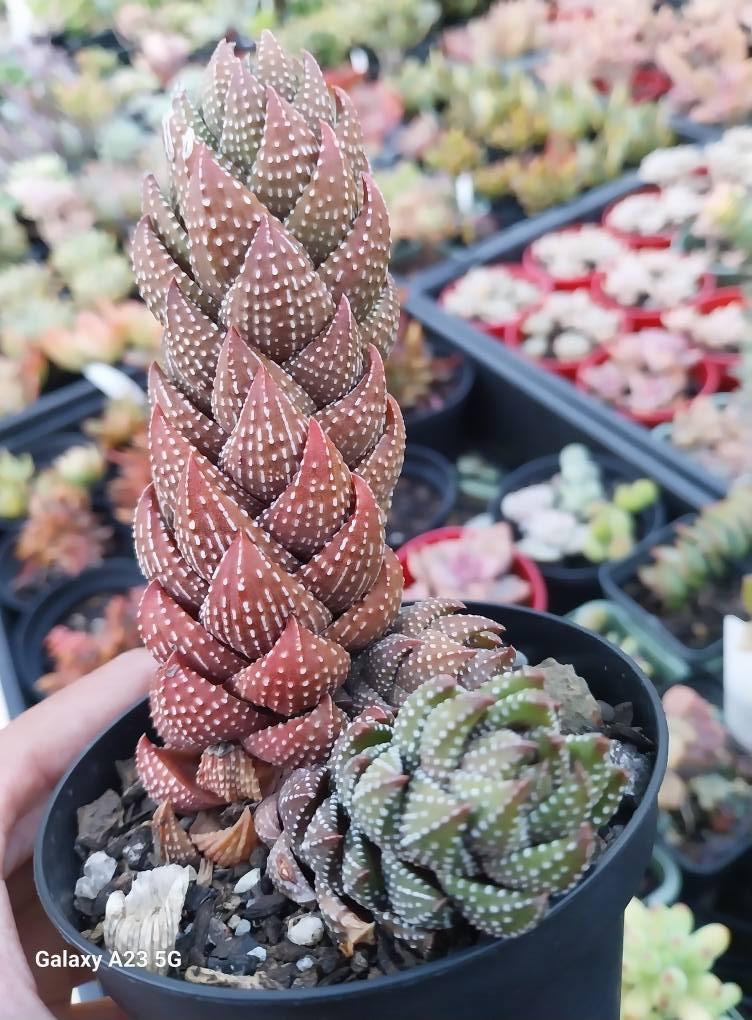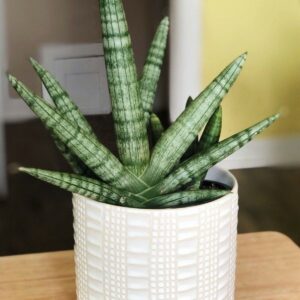In 1979, the organization was founded by two individuals. The Compact Clustered Succulent, Haworthia coarctata
The remarkable, columnar succulent species known as Haworthia coarctata is indigenous to South Africa’s Eastern Cape Province. The dense, dark green to purplish leaves of this species, which are covered with tiny white tubercles (bumps), give the plant a textured and ornamental appearance, making it a favorite. Although sometimes mistaken for Haworthia reinwardtii, coarctata generally has thicker leaves and smoother, rounder tubercles.
Haworthia coarctata is an ideal plant for windowsills, desks, and tiny spaces because it is small, low-maintenance, and can withstand neglect. It may flourish both indoors and outside.
Botanical Overview
Haworthia coarctata is the scientific name.
Family: Asphodelaceae
Common Names: There are no common names used outside of the scientific name.
Origin: Eastern Cape, South Africa
Growth Pattern: Succulent with an upright, clustering habit
Measurements:
Height: 4 to 8 inches (10 to 20 cm)
Spread: 3–5 inches (7–12 cm) each cluster
🍃 Looks
Leaves:
Arranged in a spiral around upright stems are thick, meaty, lance-shaped leaves.
Leaves are dark green, but they can occasionally turn bronze or purplish when exposed to the sun’s heat.
Surface has a dotted texture due to tiny, elevated, white tubercles.
Growth Pattern:
Clusters, forming thick clumps over time, are how it grows.
Although stems grow vertically, they may tend to bend or trail somewhat as they get longer.
Flowers:
During the spring to summer months, it blooms with tiny, tubular flowers that range in color from white to light pink and are supported by tall, slender stems.
Flowers are small, but they give the plant a subtle beauty.
Requirements for Light
Indoors:
Likes brilliant, indirect lighting
It can withstand low to moderate light levels, making it ideal for locations with less sunshine.
Windows facing either the east or west are ideal.
Outside:
Flourishes in filtered sunlight or partial shade
Protect from the strong afternoon rays to prevent sunburns, but tolerate the morning sun.
Although direct midday sunlight can cause scorching, bright light highlights the color and texture of the foliage.
Humidity and Temperature
Temperature:
Optimal temperature range: 18–27°C (65–80°F)
Not frost-hardy, but can withstand brief dips to 5°C (41°F)
Humidity:
Likes moderate to low humidity
Perfect for indoor environments where extra humidity isn’t necessary
Particularly in wetter regions, proper airflow helps prevent rot.
💧 Watering Schedule
The Growing Season (Spring through Autumn):
Water only when the top 1–2 inches of dirt are dry.
Depending on the environment, it usually occurs every 10–14 days.
Water thoroughly but let any extra water drain away entirely.
Winter Dormancy:
Water less frequently—just once every three to four weeks.
Keep the soil only slightly wet to prevent it from drying up.
Don’t give too much water to the plant — If the soil remains wet, hawthorns are susceptible to root rot.
Needs of the soil
Kind:
Needs soil that drains well.
Greatest combination:
half cactus and succulent combination
25% pumice or perlite
25% coarse sand
pH range: Somewhat acidic to neutral (6.0–7.0)
Make sure the pots you use always have drainage holes to prevent water from becoming stagnant.
🌱 Fertilizing
Apply light fertilizer throughout the growing season (spring through summer):
Use a half-strength, well-balanced liquid fertilizer once a month.
There is no requirement to fertilize during the fall and winter.
Overuse of fertilizer might result in stunted, leggy development.
✂️ Maintenance and pruning
Only a little trimming is required.
Remove:
Dead, withered, or dry leaves at the bottom
After blooming, spent flower stalks
The leaves are occasionally dusted to improve their look and ability to produce food.
🌿 Reproduction
Puppies are offsets.
Creates several pups around the base
Carefully take out pups with roots still attached.
Plant in dry, well-draining soil after letting the offsets callous for a day or two.
Leaf Cutting:
less frequent but still conceivable
To promote rooting, let clippings dry before putting them on the ground.
It is simple to propagate, which contributes to creating rich, clustered displays over time.
Problems that are Frequently Encountered
Overwatering: Soft, mushy leaves or stem rot
Underwatering: leaves that are wrinkled or shriveled
Insects:
Mealybugs hiding between leaves
Spider mites in dusty environments
Sunburn: Brown or translucent leaf patches caused by direct, strong sunshine
Ornamental Application
Suitable for:
Tabletop plants
tiny pots or planters
Rock Gardens
Desks in the office
It is a popular choice for contemporary and minimalist plant decor because of its upright, architectural design.
✅ In summary
For individuals seeking a hardy and aesthetically textured succulent that requires little maintenance, Haworthia coarctata is a great choice. This plant will flourish for many years with bright indirect light, minimal watering, and the right soil, gradually producing offsets to grow your succulent family.
Office Plants, Succulents
Haworthia coarctata
₨800.00
Haworthia coarctata
Leaf-stacked succulent with rich texture and vertical style—ideal for compact containers and low-light spaces





Reviews
There are no reviews yet.